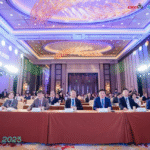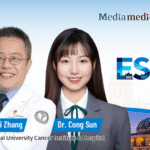
The European Society for Medical Oncology (ESMO) Congress 2025 was grandly held in Berlin, heralding a new era of scientific innovation in oncology.In hematology, this year’s highlights encompassed several cutting-edge research directions—from unraveling the mechanisms of CAR-T resistance and exploring dual-target immunotherapies that may enhance precision and efficacy, to studies on treatment-free remission in multiple myeloma, and the creation of single-cell immune atlases offering novel insights into hematologic disease mechanisms. These achievements collectively reflect the continued progress and innovation in biomedical science and bring new hope for patients with hematologic malignancies.
To spotlight major advances in the field and promote scientific exchange, Oncology Frontier – Hematology News invited Prof. Liang Wang, from Beijing Tongren Hospital, Capital Medical University, to share his professional perspective on the latest study results and their clinical significance, and to discuss future directions in CAR-T therapy research.
Abstract 1240O: CD19/CD22 Bispecific CAR-T Therapy in Relapsed/Refractory Large B-Cell Lymphoma — A Prospective, Single-Arm, Single-Center Phase II Study
Q1
How do you evaluate the therapeutic value of the CD19/CD22 bispecific CAR-T product (CAR2219)? Compared with traditional single-target CAR-T therapies, what additional benefits might it offer to patients with relapsed or refractory large B-cell lymphoma (R/R LBCL)?
Prof. Liang Wang:Currently, outcomes for patients with relapsed or refractory large B-cell lymphoma (R/R LBCL) remain suboptimal. Although nearly ten CAR-T products have been approved globally, most target CD19 alone for the treatment of DLBCL. However, single-antigen CAR-T therapies exhibit certain limitations—response rates are moderate, and relapse after initial remission remains common.
Data from previous pivotal trials such as ZUMA-1 indicate that the median progression-free survival (PFS) after single-target CD19 CAR-T therapy is less than six months, and even among responders, median duration of response is under one year. Long-term follow-up suggests that only about one-third of patients achieve durable remission or functional cure, while the remaining two-thirds experience disease relapse or fail to respond.
To address these challenges, our study employed a dual-target CAR-T strategy simultaneously recognizing CD19 and CD22 via a tandem scFv design. Results demonstrated a higher complete response (CR) rate and significantly prolonged PFS, suggesting that dual-target CAR-T therapy could provide meaningful survival benefits for this difficult-to-treat population.
Q2
In patient selection, what considerations were taken into account? Given that CAR2219 showed high response and survival rates even in heavily pretreated R/R LBCL patients, do you think bispecific CAR-T therapy may become a preferred option for such cases?
Prof. Liang Wang:Historically, CAR-T clinical trials have applied stringent eligibility criteria—enrolling patients with relatively preserved performance status and low tumor burden. Yet in real-world practice, most patients present with multiple relapses, high tumor burden, and poor performance status (ECOG 3–4). According to traditional trial standards, many of these patients would not qualify for enrollment. Nonetheless, for these individuals, CAR-T therapy remains a critical and often last therapeutic option.
In our study, we included these high-risk patients and used bridging therapy to temporarily control disease progression and reduce tumor burden before CAR-T infusion. The results were encouraging—many patients achieved renewed remission following dual-target CAR-T treatment, and subsequent maintenance therapy markedly prolonged remission duration.This experience demonstrates that innovative combination strategies, integrating bridging therapy with bispecific CAR-T infusion, can yield favorable outcomes even in patients with aggressive, high-tumor-burden disease.
Q3
Your study incorporated both bridging and maintenance therapy. How did these adjunctive treatments influence the efficacy of CAR2219, and how should such strategies be personalized in clinical practice to maximize benefit?
Prof. Liang Wang:In real-world settings, many patients with rapidly progressing and bulky disease may deteriorate before CAR-T cells are ready for infusion. Hence, bridging therapy plays an essential clinical role in stabilizing the disease during CAR-T manufacturing.In this trial, we employed an MPD regimen consisting of mitoxantrone liposome, polatuzumab vedotin, and dexamethasone, which achieved rapid disease control in all patients, with some reaching complete remission after just one cycle—thereby enabling timely CAR-T infusion.
At the day-28 evaluation post-infusion, some patients who had not achieved CR still exhibited ongoing CAR-T expansion. Mechanistic analysis revealed upregulated PD-1 expression on CAR-T cells, indicating potential exhaustion that could impair durability. Consequently, maintenance therapy incorporating PD-1 inhibitors, either alone or combined with small-molecule agents such as XPO1 inhibitors, BTK inhibitors, or HDAC inhibitors, was used. This approach appears to extend CAR-T persistence, sustain cytotoxic activity, and promote central memory T-cell differentiation, thereby enhancing long-term antitumor efficacy.In summary, bridging and maintenance therapy represent integral components of comprehensive CAR-T management. Their integration into standard clinical pathways will be key to optimizing real-world outcomes.
Q4
Although this Phase II trial is ongoing, how do you envision the impact of this therapeutic strategy on future clinical practice? What further directions should be explored to refine CD19/CD22 bispecific CAR-T therapy?
Prof. Liang Wang:While several single-target CAR-T therapies have already been approved, their efficacy remains limited in R/R LBCL. As a result, global research efforts are now shifting toward dual-target (CD19/CD22, CD19/CD20) and even triple-target (CD19/CD20/CD22) CAR-T constructs. Current evidence suggests that such multi-target CAR-T therapies demonstrate superior efficacy and manageable safety profiles. Therefore, dual- or multi-antigen CAR-T products are likely to become major treatment modalities in the coming years.That said, CAR-T therapy alone cannot address all clinical challenges. Future optimization should encompass the entire therapeutic continuum—from pre-leukapheresis preparation and selection of optimal bridging therapy, to maintenance regimens after infusion. Establishing evidence-based strategies for each step will require prospective, multi-center clinical trials to define the most effective integrated treatment pathways.
Conclusion
Prof. Wang emphasized that CD19/CD22 bispecific CAR-T therapy represents a promising advancement for patients with relapsed or refractory LBCL, demonstrating both robust efficacy and favorable safety. As research progresses, the integration of multi-target CAR-T designs with comprehensive treatment strategies may redefine the therapeutic landscape for B-cell lymphomas—offering renewed hope for long-term remission and survival.


